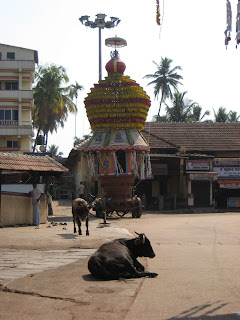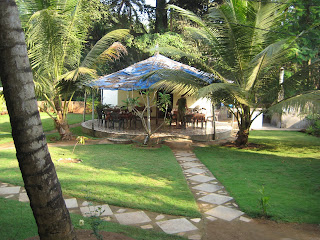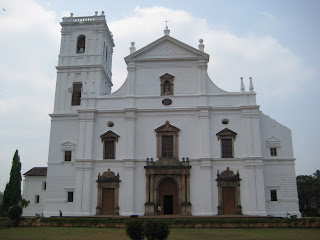Here are the recipes that we learned to make at our cooking class in Fort Kochin. All recipes are courtesy of Jasmin at Jasmin Villa. Enjoy!!
Chappati
Combine in bowl:
400 grams of flour (a mix of half white and half wheat is best)
½ tsp salt
Mix together with fingers.
Add 3 tbsp sunflower oil and mix in with fingers.
Add 1-1½ cups of water and mix/knead until it comes together / holds together but not wet.
Let stand in mixing bowl for ~1 hour covered with a plate or towel.
Flour surface and knead 3 times.
Roll into balls (whatever size you want, but when rolled out they will need to fit in pan.)
Flatten each ball with palm and roll out (adding more flour as needed to prevent sticking) to ~1/8” thick.
Place on hot cast iron on medium heat until it starts to bubble. Flip with spatula, drizzle with sunflower oil and cook until bubbly and lightly brown. Flip back and forth adding oil as needed and flattening down the bubbles as you go. Cook until both sides are lightly brown.
(Chappati should have a similar texture to soft tortillas.)
Coconut Vegetable Curry
2 tbsp coconut oil (or sunflower)
10 curry leaves
3 cloves of garlic, very finely chopped
1 piece of ginger (garlic clove size), very finely chopped
1 small red onion, thinly sliced
½ tsp chili powder
½ tsp turmeric
½ tsp garam masala
½ tsp ground coriander
Salt
1 tomato, chopped
5 long beans, cut into bit size pieces
2 small potatoes, cut into bite size pieces
2 small carrots, cut into bite size pieces (rounds cut into quarters)
2 green chilies, sliced lengthwise
1 cup freshly grated coconut (if use dried grated coconut, the mixture’s consistency will be a bit dry and chunky and it may have to be strained. Can also use coconut milk.)
10 cashew nuts
1 tbsp finely chopped cilantro leaves
In a kadai (or dutch oven), add oil on medium-high heat. Add curry leaves, ginger, garlic, and onion and sauté until soft. Add the four dried spices (chili powder through coriander) with salt to taste for 30 seconds. Add tomato for 1 minute. Add rest of vegetables for about 1 minute. Add about 1½ cups of water
and cover. Cook until soft at a low boil.
Meantime, blend coconut, cashews, and about 1 cup of water in a blender until liquid.
When veggies are soft, stir in cilantro and coconut mixture and serve.
Vegetarian Pulao
2 tbsp + 1 tsp ghee, divided
5 small pieces of cinnamon
3 green cardamom pods
6 cloves
2 small red onion, thinly sliced
10 green beans, cut into bite sized pieces
2 small carrots, cut into thin matchsticks about 1 inch long
1 cup basmati rice
4 tbsp chopped mint leaves
1 tbsp chopped cilantro leaves
1 tbsp cashews
2 tbsp raisins
Salt
Heat a kadai (or dutch oven) over medium-high heat and add ghee. When hot, add cinnamon, cardamom and cloves for about 30 seconds. Add onion and fry until golden brown. Add beans and carrots for 1 minute. Add rice and stir for 30 seconds. Add 2 cups of water, mint leaf, cilantro, and salt and stir. Cover. Cook for 5 minutes on high flame then lower to low flame for 15 minutes.
Meanwhile, in a small fry pan, add 1 tsp ghee over medium heat. Add raisins and cashews. Brown the nuts, stirring constantly. Add to finished rice and serve.
Dal
¾ cup yellow dal (toordal)
3 green chilies, cut in half
1 tsp turmeric
¾ cup red onion, finely chopped
1 cup water
Salt
2 tsp coconut or sunflower oil, divided
2 tsp mustard seeds
10 curry leaves
Add dal, chilies, turmeric, onion, and water in a pressure cooker until soft (5 whistles). (This step can be done in a dutch oven until dal is soft.) Add salt to taste and transfer to bowl. In a small fry pan, add 1 tsp of oil and mustard seeds for about 1 minute. Add curry leaves for about 15 seconds and add to dal. Serve.
Vegetable Raita
Combine the following:
1 medium red onion, finely diced
1 tomato, chopped small
1 cup plain yogurt
Salt to taste
Can add green chili or cucumber, too.
Pappadum
Can buy at Indian grocery.
Poke hole in center with knife before frying.
Add sunflower oil to small fry pan and heat until small piece of pappadum sizzles when added.
Fry each side (turning with a fork) for just a few seconds until puffed and golden yellow.
Okra
Mix together:
2 tsp ground coriander
¼ tsp ground black pepper
¼ tsp garam masala
¼ tsp salt
Trim ends off 8 okra and make a small slit lengthwise in the middle of each. Stuff each okra with spice mixture. Fry in coconut oil and brown on each side.
Garam Masala
50 grams green cardamom pods
50 grams whole cinnamon sticks
50 grams cloves
15 grams star anise
15 grams mace
25 grams fennel seeds
Toast over a low flame and grind together in a spice grinder.
Store in airtight container in refrigerator.



























































